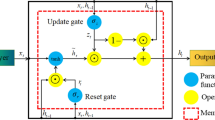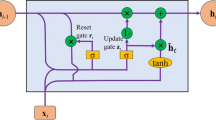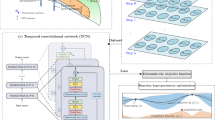Abstract
Landslide deformation prediction has significant practical value that can provide guidance for preventing the disaster and guarantee the safety of people’s life and property. In this paper, a method based on recurrent neural network (RNN) for landslide prediction is presented. Genetic algorithm is used to optimize the initial weights and biases of the network. The results show that the prediction accuracy of RNN model is much higher than the feedforward neural network model for Baishuihehe landslide. Therefore, the RNN model is an effective and feasible method to further improve accuracy for landslide displacement prediction.







Similar content being viewed by others
References
Huang RQ (2007) Large-scale landslides and their sliding mechanisms in China since the 20th century. Chin J Rock Mech Eng 26(3):433–454
Tang C, Rengers N, van Asch TWJ (2011) Triggering conditions and depositional characteristics of a disastrous debris flow event in Zhouqu City, Gansu Province, Northwestern China. Nat Hazards Earth Syst Sci 11(11):2903–2912
Kanungo DP, Arora MK, Sarkar S, Gupta RP (2006) A comparative study of conventional, ANN black box, fuzzy and combined neural and fuzzy weighting procedures for landslide susceptibility zonation in Darjeeling Himalayas. Eng Geol 85:347–366
Neaupane KM, Achet SH (2004) Use of backpropagation neural network for landslide monitoring: a case study in the higher Himalaya. Eng Geol 74(3–4):213–226
Li XZ, Kong JM, Wang ZY (2012) Landslide displacement prediction based on combining method with optimal weight. Nat Hazards 61:635–646
Saito M (1965) Forecasting the time of occurrence of a slope failure. In: Proceedings of the 6th international conference on soil mechanics and foundation engineering, Montreal, pp 537–541
Fukuzono T (1985) A new method for predicting the failure time of a slope. In: Proceedings of the fourth international conference on landslides, Tokyo, pp 145–150
Voight B (1989) A relation to describe rate-dependent material failure. Science 243(4888):200–203
Xu JL, Liao XP (1996) Prediction for Huangci landslide and its theory and method. Chin J Geol Hazard Control 7(3):18–25
Helmstetter A, Sornette D, Grasso JR, Andersen JV, Gluzman S, Pisarenko V (2004) Slider-block friction model for landslides: application to Vaiont and La Clapiere landslides. J Geophys Res 109(B02409):1–15
Sornette D, Helmstetter A, Andersen JV, Gluzman S, Grasso JR, Pisarenko V (2004) Towards landslide predictions: two case studies. Phys A Stat Mech Appl 338(3–4):605–632
Lu P, Rosenbaum MS (2003) Artificial neural networks and grey systems for the prediction of slope stability. Nat Hazards 30:383–398
Randall WJ (2007) Regression models for estimating coseismic landslide displacement. Eng Geol 91(2–4):209–218
Long H, Qin SQ, Zhu SP, Wan ZQ (2001) Nonlinear dynamic model and catastrophe analysis of slope evolution. J Eng Geol 9(3):331–335
Wu YP, Teng WF, Li YW (2007) Application of grey-neural network model to landslide deformation prediction. Chin J Rock Mech Eng 26(3):632–636
Ran YF, Xiong GC (2010) Study on deformation prediction of landslide based on genetic algorithm and improved BP neural network. Kybernetes 39(8):1245–1254
Feng XT, Zhao HB, Li SJ (2004) Modeling non-linear displacement time series of geo-materials using evolutionary support vector machines. Int J Rock Mech Min Sci 41(7):1087–1107
Dong H, Fu HL, Leng WM (2007) Nonlinear combination predicting based on support vector machines for landslide deformation. J China Railw Soc 29(1):132–136
Melchiorre C, Castellanos Abella EA (2011) Evaluation of prediction capability, robustness, and sensitivity in non-linear landslide susceptibility models, Guantanamo. Cuba. Comput Geosci 37:410–425
Yu W (2005) State-space recurrent fuzzy neural networks for nonlinear system identification. Neural Process Lett 22:391–404
Cordova J, Yu W (2012) Two types of Haar wavelet neural networks for nonlinear system identification. Neural Process Lett 35:283–300
Cagdas HA, Erol E, Ufuk Y (2010) Forecast combination by using artificial neural networks. Neural Process Lett 32:269–276
Lee H, Park Y (1991) Nonlinear system identification using recurrent networks. In: Proceedings of the 1991 IEEE international joint conference on neural networks, Vancouver, pp 2410–2415
Karaboga D, Kalinli A (1997) Training recurrent neural networks for dynamic system identification using parallel Tabu Search Algorithm. In: Proceedings of the 12th IEEE international symposium on intelligent control, Istanbul, pp 113–117
Yu W (2004) Nonlinear system identification using discrete-time recurrent neural networks with stable learning algorithms. Inf Sci 158:131–147
Pham DT, Karaboga D (1999) Training Elman and Jordan networks for system identification using genetic algorithms. Artif Intell Eng 13:107–117
Grefenstette JJ (1986) Optimization of control parameters for genetic algorithms. IEEE Trans Systems Man Cybern SMC–16(1):122–128
Zhang MS, Li TL (2011) Triggering factors and forming mechanism of loss landslides. J Eng Geol 19(4):530–540
Acknowledgments
The work is supported by the Natural Science Foundation of China under Grant 60974021, the 973 Program of China under Grant 2011CB710606, the Fund for Distinguished Young Scholars of Hubei Province under Grant 2010CDA081, and the Specialized Research Fund for the Doctoral Program of Higher Education of China under Grant 20100142110021.
Author information
Authors and Affiliations
Corresponding author
Rights and permissions
About this article
Cite this article
Chen, H., Zeng, Z. & Tang, H. Landslide Deformation Prediction Based on Recurrent Neural Network. Neural Process Lett 41, 169–178 (2015). https://doi.org/10.1007/s11063-013-9318-5
Published:
Issue Date:
DOI: https://doi.org/10.1007/s11063-013-9318-5




